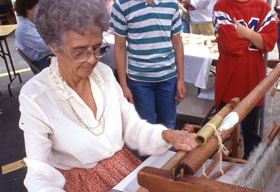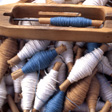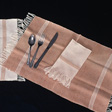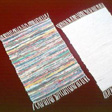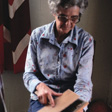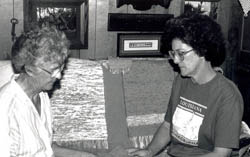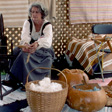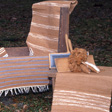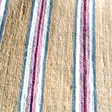Table of Contents
Introduction
Profiles of Masters and Apprentices

Gladys Clark lives in the community of Scott, which is located on the prairie southwest of Lafayette. She is probably the only remaining traditional Acadian weaver of coton jaune, or brown cotton. Gladys learned the skills of growing, carding, spinning, and weaving brown cotton from her grandmother and her mother, Colastie LeBlanc, who recently passed away at the age of 95.
Prior to their removal from Canada, the Acadians had raised sheep and woven fabric from wool. In 1765, upon arrival in South Louisiana, the hot, humid climate caused the Acadians to begin using home grown cotton as a replacement for wool. The women continued to card (prepare for spinning), to spin, and to weave beautiful fabric for their own use. However, within 50 years, the expert weaving of the Acadian ladies became recognized by other groups living in the general area, and a cottage industry had begun.
Gladys' ancestors settled south of Lafayette, on Isle de Cannes, where she and many of her relatives still live today. For several generations, weaving was a major occupation of Acadian women. All the ladies living along the coulee (creek) would spin and weave. They would frequently get together for carding parties, la cardrie, and together prepare the cotton for spinning. Gladys recalls these carding parties from her childhood, "Everyone would bring their cards and extra chairs would be brought in from the neighbors close by. We would card all afternoon, with a break for lemonade and cookies. Then, Mama would spin in the evening."
Although the Acadians used white cotton as well, the brown cotton was very popular because it already had a natural color and didn't require dyeing. This coton jaune probably originated in Mexico, and in south Louisiana, the seed was handed down from one generation to another for planting each year. Today, very little brown cotton is grown. Gladys and her husband plant and harvest their own. They also hand pick it, and then take it to North Louisiana for ginning to remove the seeds. The brown cotton is ginned only after all the white cotton of the season is completed. The next step is for the cotton to be carded.
For carding, a small quantity of the seeded cotton is placed between rectangular steel brushes to be combed and stretched until the fibers are smooth and form a narrow strip approximately eight inches long. This strip is called the rolag, and the brushes are called cards. The rolag is used to spin into thread.
By the time she was nine years old, Gladys could spin and card. She, along with three sisters, helped her mother. All of them could card, but Gladys does not recall whether or not her sisters could spin. This work takes much patience since one must sit for many long, tedious hours at the loom, at the spinning wheel, or carding.
Good spinning requires a great deal of skill. Gladys uses a very old Acadian spinning wheel today. She explains the difficulty of spinning: "You must know just how hard, how fast, and when to pull the thread. You also have to have just the right amount of tension, or the thread will snap." The spindle is turned by the wheel, which in turn is activated by a foot pedal. Two and a half to three yards of thread can be made from one rolag.
Weaving is the part that Gladys enjoys the most. However, as a young girl she preferred sewing to weaving. In the 1940s, the LSU Extension Service helped to re-organize the cottage industry, and that is when Gladys became serious about her craft.
Gladys recalls that her mother used to weave year round. She had a little house in the yard where she would set up the loom. Not every weaver had a loom, so this valuable tool was shared between households. Each time Gladys' mother set up the loom, she would work on it until she had completed 8 or 10 blankets before taking it down. This means that after warping the loom once, as many as ten blankets could be made. The warping board for the type of loom used by Gladys' mother is very large, being two and a half to three yards in width.
Warping is the first thing done in the process of weaving with the loom. The warp threads run lengthwise and hold the weft in place as it is woven. Gladys' warping board is smaller than those used by her ancestors, and her warp threads are made of commercial 20/2 weight white thread. Even so, it takes about two days to warp or thread the loom. Gladys makes primarily placemats, rugs, and napkins. Some are entirely made of coton jaune and others are blends of white and brown.
When the warp threads are used, the weaver doesn't have to completely re-thread each time. However, new warp threads must be put in place by cutting the old threads in front of the reed that holds it, then tying new threads to the cut ends. This is a tedious, but somewhat less lengthy process than completely re-warping. Carding for one placemat takes one and a half to two hours and just as long for spinning.
The preservation of crafts such as spinning and weaving is very important in the process of piecing together the past. For a long, long time all fabrics were made this way. It was not just a hobby, but something essential. Because women spent so much time at this task, they often combined it with socializing in order to break the tedium.
Gladys Clark has taken an active role in ensuring that her craft, as well as its historical context, is not forgotten. Gladys has demonstrated spinning and weaving at the Festival of American Folklife in Washington D. C., at the Louisiana World Exposition, and at many other fairs and festivals throughout Louisiana such as Festival Acadiens, the Louisiana Folklife Festival, the Jazz and Heritage Festival and many others. Through these events and through the Louisiana Folklife Apprenticeship Program, a strand of our past, which has had utilitarian, artistic, and social threads is being preserved.
The Folklife Program awarded an apprenticeship grant for Elaine L. Bourque to learn how to grow, spin, and weave coton jaune under the guidance of Gladys Clark. Elaine Bourque, who has her own strong feelings for family and Acadian traditions, has enthusiastically embraced this interesting and difficult task. She reports many things she has learned, such as that "the smaller, finer, even rolags are easier to spin evenly as Mrs. Clark does!"
The first brown cotton that Elaine Bourque used during her apprenticeship was grown and given to her by a friend. However, in 1990, she planted her own.
Because her intention is to someday spin and weave as well as Gladys Clark does, Elaine Bourque makes her pieces slightly different from those of her mentor. This way, when the skill of the apprentice has reached master level, there will be something to distinguish their creations from one another. For example, on placemats, Elaine weaves five white stripes on brown instead of four. Another innovation is Elaine's use of Job's Tears beads from her garden to accent various pieces. She says, "I grow Job's Tears beads in my garden for rosaries, so I have tried several pieces with beads. . . . I think beads were grown by early Acadian settlers and they made rosaries, so I feel it is in keeping with an old Acadian tradition, but different from Mrs. Clark's work." Other traditional items that Gladys Clark has taught her apprentice to make are woven rag rugs and placemats.
Elaine Bourque says about her teacher, "I will always appreciate her willingness to help me with this apprenticeship. I think Mrs. Clark will never be replaced when she can no longer do her spinning and weaving and it will be our loss! . . . But, I will try to keep alive, as best I can, the tradition of Acadian brown cotton spinning and weaving."


